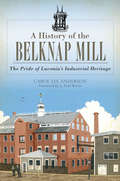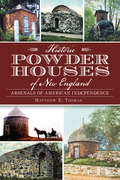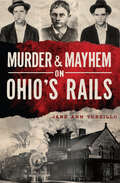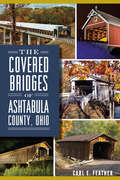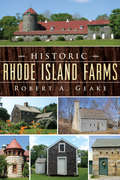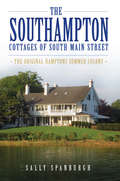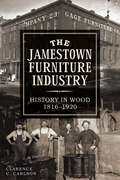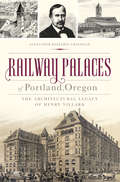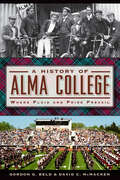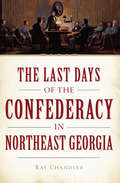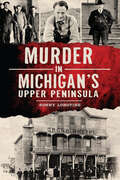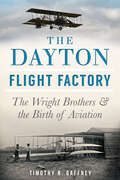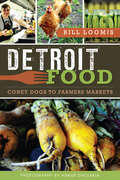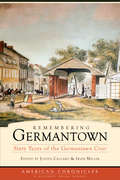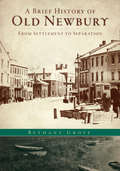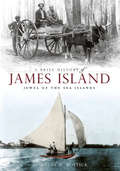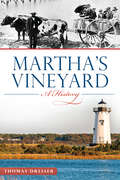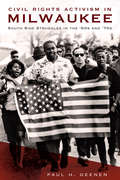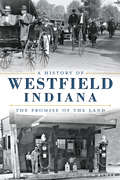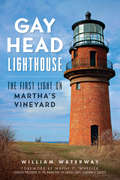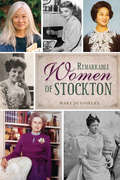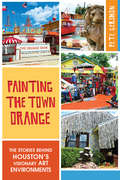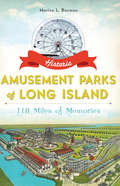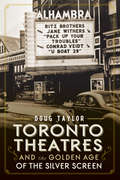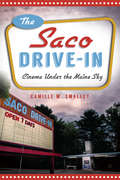- Table View
- List View
A History of the Belknap Mill: The Pride of Laconia's Industrial Heritage (Landmarks)
by Carol Lee AndersonLaconia's Belknap Mill thrived in the boom of the Industrial Revolution. The historic mill swiftly rose to the forefront of the city's hosiery industry in the nineteenth century. Lakes Region historian Carol Lee Anderson reveals the mill's unique history, including its inventive, entrepreneurial owners, their climb to industrial success and the challenges they overcame. This fascinating story encompasses the saga of countless French-Canadian immigrants whose arrival in the Lakes Region influenced the course of industry and daily life in the city of Laconia. The mill's story continues, and the preservation of this historic textile mill includes a fierce struggle of historic values versus urban renewal. Learn how this early symbol of the Industrial Revolution fought to become the pride of Laconia's industrial heritage.
Historic Powder Houses of New England: Arsenals of American Independence (Landmarks)
by Matthew E. ThomasIn the turbulent history of colonial New England, more than two hundred powder houses were built to store gunpowder, guns and armaments. Even the spark from a metal shoe nail could ignite their contents, so they often sat in remote sections of town. These volatile storehouses played a vital role in earning and preserving American independence. It was, after all, to a powder house in Concord, Massachusetts, that the British army marched in April 1775 to seize colonists' gunpowder. The British were thwarted, and the colonists' defense of the powder house ignited the Revolutionary War. Add to this the duels, murders, public hangings and tragic explosions that checkered the history of these structures, and the reader will discover a fascinating and forgotten aspect of our New England heritage. Using meticulous research, Matthew Thomas narrates the colorful histories of New England's powder houses as he resurrects their historical significance in early American history.
Murder & Mayhem on Ohio's Rails (Murder And Mayhem Ser.)
by Jane Ann TurzilloAll aboard for a breakneck trip into history, as the author of Wicked Women of Ohio details the Buckeye State&’s most daring train holdups. Ride Ohio&’s rails with some of the bravest trainmen and most vicious killers and robbers to ever roll down the tracks. The West may have had Jesse James and Butch Cassidy, but Ohio had its own brand of train robbers. Discover how Alvin Karpis knocked off an Erie Railroad train and escaped with $34,000. Learn about the first peacetime train holdup that took place in North Bend when thieves derailed the Kate Jackson, robbed its passengers and blew the Adam&’s Express safe. Make no mistake—railroading was a dangerous job in bygone days. Includes photos! &“Ohio was plagued by train bandits, too, and some of them were shockingly violent. Journalist Jane Ann Turzillo has researched 10 interesting cases for her book.&” —Akron Beacon Journal
The Covered Bridges of Ashtabula County, Ohio (Landmarks)
by Carl E. FeatherWhen its first covered bridge was constructed on the Ashtabula-Trumbull Turnpike in 1832, Ashtabula County was closer to frontier than a "new Connecticut." Its rutted roads promised adventure and suggested prosperity but also great hardship. Covered bridges, made mostly of local timber, would eventually soften the brutality of travel, isolation and a well-watered landscape. Their proliferation and preservation gave Ashtabula County the nickname "Covered Bridge Capital of the Western Reserve." Admire both famous and forgotten crossings with Carl E. Feather, who has spent over a quarter century mired in muddy creek beds, camera in hand, waiting for the perfect light."
Historic Rhode Island Farms (Landmarks)
by Robert A. GeakeDating back to the colonial era, the historic barns and outbuildings of Rhode Island have withstood the test of time. From the state's early barnyard taverns to the modern-day horse and dairy farms that populate rural Rhode Island, each of these buildings has a story to tell. In the mid-eighteenth century, the Narragansett planters bred horses on their farms in southern Rhode Island. Later, dairy farms sprang up across the region. Milking barns were built on the largest farms in the state, including the Theinhert Dairy Farm and Barn in Lincoln. Before the advent of electric trolleys, urban barns sheltered horses for early tramcar transportation. Each barn is a beloved reminder of the state's history. Join author Robert A. Geake as he explores the origins and evolution of Rhode Island's farms.
Southampton Cottages of South Main Street, The: The Original Hamptons Summer Colony
by Sally SpanburghIn 1887, Southampton was proclaimed "the most charming of all small cities by the sea." From 1870 to 1930, the colonial farmsteads that dotted its oldest street made way for the stately second homes of America's most fashionable elite. Hollywood royalty like Ginger Rogers and Jimmy Stewart lived and played in these magnificent second homes. Situated on the east side of Lake Agawam, South Main Street cottagers fished, bicycled, sailed and walked to the beach and into the village throughout the summer season. Today all but five of these grand landmarks survive. Local author Sally Spanburgh uses her historical and architectural expertise to tell the stories behind the construction of these beautiful homes and their remarkable owners.
Jamestown Furniture Industry, The: History in Wood, 1816-1920
by Clarence CarlsonWhile all but gone today, Jamestown's furniture industry was once the second-largest producer of furniture in the United States. Manufacturing boomed from 1816, when William Breed and Royal Keyes opened their shops, to the 1920s, when Jamestown was still one of the top wood furniture producers in the country. In the nineteenth century, the thriving railroad industry allowed Jamestown's quality creations to be distributed nationwide. After the Civil War, an influx of Swedish immigrants brought their craftsmanship and skills to Jamestown, forming Morgan Manufacturing, Empire Furniture Company and many others. Then, their pieces were valued for quality and durability; today, they're coveted by collectors as beautiful antiques. Local expert Clarence Carlson uncovers the fascinating story of Jamestown furniture.
Railway Palaces of Portland, Oregon: The Architectural Legacy of Henry Villard (Landmarks)
by Alexander Benjamin CragheadIn 1883, railroad financier Henry Villard brought Portland and the Pacific Northwest their first transcontinental railroad. Earning a reputation for boldness on Wall Street, the war correspondent turned entrepreneur set out to establish Portland as a bourgeoning metropolis. To realize his vision, he hired architects McKim, Mead & White to design a massive passenger station and a first-class hotel. Despite financial panics, lost fortunes and stalled construction, the Portland Hotel opened in 1890 and remained the social heart of the city for sixty years. While the original station was never built, Villard returned as a pivotal benefactor of Union Station, saving its iconic clock tower in the process. Author Alexander Benjamin Craghead tells the story of this Gilded Age patron and the architecture that helped shape the city's identity.
A History of Alma College: Where Plaid and Pride Prevail (American Chronicles)
by Gordon G. Beld David C. McMackenCome along with authors Gordon Beld and David McMacken on a trip down memory lane to Alma College, a mid-Michigan school with a fascinating past, rich heritage and impressive influence. Look on as thousands of spectators flock to the campus for the annual Highland festival. Sit in the front row while a yet unknown young performer introduces you to a new song, "Take Me Home, Country Roads." Peek into a voting booth to see the ballot listing two former Alma students who are candidates for the U.S. vice presidency--in the same election. Learn how Alma students reached out to make a difference here at home and around the world..
Last Days of the Confederacy in Northeast Georgia, The (Civil War Series)
by Ray ChandlerIn 1861, northeast Georgians were the driving force into secession and war. In 1865, Confederate president Jefferson Davis, his government collapsing and himself a wanted man, brought the reality of the war to the region's doorstep. Governor Joseph Brown, U.S. senator Robert Toombs and the politically influential Howell Cobb of Athens and his brother Thomas R.R. Cobb all fought passionately for Southern independence. The region epitomized the reasons for which the South waged and supported the war, yet it was spared the destruction seen in other places. Even Sherman's Union army touched only the region's fringes. Author Ray Chandler brings to light the final act of the Confederacy in the Peach State's northeast and the lasting impact it had on Georgians.
Murder in Michigan's Upper Peninsula (True Crime)
by Sonny LongtineResidents of the idyllic villages scattered throughout the Upper Peninsula's richly forested paradise live in quiet comfort for the most part, believing that murder rarely happens in their secluded sanctuary3/4but it does, and more often than they realize. This collection of twenty-four legendary murders spans 160 years of Upper Michigan's history and dispels the notion that murder in the Upper Peninsula is an anomaly. From the bank robber who killed the warden and deputy warden of the Marquette Branch Prison to the unknown assailant who gunned down James Schoolcraft in Sault Ste. Marie, Sonny Longtine explores the tragic events that turned peaceful communities into fear-ridden crime scenes..
The Dayton Flight Factory: The Wright Brothers And The Birth Of Aviation
by Timothy R. GaffneyThe Wright brothers are known around the world as the inventors of the airplane. But few people know Wilbur and Orville invented the airplane in Dayton, Ohio--their hometown--not in North Carolina, where they tested it. Efforts to preserve historic places in the Dayton region where the Wright brothers lived and worked are paying off. Today, you can stroll the Wright brothers' neighborhood, see the original 1905 Wright Flyer III and walk the prairie where they flew it. A project to restore the Wright brothers' factory--the first American factory built to produce airplanes--will complete the picture. In this book, author Timothy R. Gaffney uses historical research and today's aviation heritage sites to retell the story of the Wright brothers from a hometown perspective.
Detroit Food: Coney Dogs to Farmers Markets (American Palate)
by Bill LoomisThe infamous images of Detroit's crumbling buildings, abandoned homes and weed-choked parks are known worldwide. Seldom shown are the city's thriving food ways, quietly rebuilding neighborhoods block by block with urban farms, locally made fare, new restaurants and an innovative, homegrown spirit that is attracting entrepreneurs and culinary enthusiasts from across the nation. Old neighborhoods are coming back to life with the smell of simmering soup, the crunch of new pickles and the aroma of all-day barbeque. Magnificent Art Deco clubs and speakeasies painstakingly restored to their former beauty are busy serving great local food. Author Bill Loomis goes behind the graffiti and ruins to explore how the passion for eating well is proving essential to Detroit's comeback..
Remembering Germantown: Sixty Years of the Germantown Crier (American Chronicles)
by Irvin Miller Judith CallardWith grit and gumption, the residents of Germantown propelled their community from a sleepy backwater to a thriving urban neighborhood. Through charming first-person accounts and fascinating narratives culled fromsixty years of the Germantown Crier, readers may catch a glimpse of the feisty Germantowners who proudly honor their past without ceasing to move forward. Meet cantankerous Ann Shermer, a nineteenth-century Bethlehem Pike tollkeeper who enforced the fare with the help of her trusty flintlock pistol, and the town�s enforcer of morality, �civilizer� Samuel Harvey. Whether a tale from the storied King of Prussia Inn, which housed greats like George Washington and Gilbert Stuart, or a memory of a childhood encounter with Louisa May Alcott, each vignette in this collection crafts a poignant portrait.
A Brief History of Old Newbury: From Settlement to Separation
by Bethany GroffIn the first ten years of its settlement, the town of Newburywitnessed murders, kidnappings, earthquakes and a plague of caterpillars. The century that followed--marked by religious conflict, Indian uprisings and public scandal--proved no less challenging to the early Puritan community.In 1640, Massachusetts Governor John Winthrop noted, "Aspeople increased, so sin abounded." But through the turmoil, Newbury's citizens harnessed the region's abundant natural resources and developed a thriving community. Author Bethany Groff introduces the compelling personalities that shaped the history of Old Newbury up until 1764, when Newburyport received its independence from the mother town. From the scandalous exploits of Dr. Henry Greenland to the courageous and sacrificing acts of founding families like the Emerys, Dummers and Pikes, A Brief History of Old Newbury provides a captivating glimpse into the verve of thisearly New England town.
A Brief History of James Island: Jewel of the Sea Islands (Brief History)
by Douglas W. BostickIn this engaging volume, local historian Douglas Bostick reveals the unacknowledged history of the second community in South Carolina, settled in 1671. Whether investigating prehistoric clues about Native American life before European settlement, detailing the history of agriculture and the reign of King Cotton, following armies from multiple wars or chronicling the triumph of equality on the greens of Charleston's Municipal Golf Course, Bostick tells the story of James Island as only a native son can. Join Bostick as he brings this small jewel of an island out of Charleston's shadow and into the light of its own rich, historic assets.
Martha's Vineyard: A History (Brief History)
by Thomas DresserMartha's Vineyard is cherished by many as a summer paradise, but few know of its rich past. Descendants of the first Native American inhabitants still reside on the Vineyard. Once a critical whaling hub, the island's success drew in newcomers from around the world. Following the Civil War, land developers set their sights on attracting tourists to the island's scenic beaches, and soon thereafter, a visit from President Grant established Martha's Vineyard as a vacation haven. From a movement to secede from Massachusetts to the making of the summer blockbuster Jaws, author Thomas Dresser weaves together the threads of the Vineyard's fascinating history. Discover how this remarkable island adapted to the times and came to be one of the most sought-out vacation destinations on the East Coast.
Civil Rights Activism in Milwaukee: South Side Struggles in the '60s and '70s
by Paul H. GeenenIn the early 1960s, as members of Milwaukee's growing African American population looked beyond their segregated community for better jobs and housing, they faced bitter opposition from the real estate industry and union leadership. In an era marked by the friction of racial tension, the south side of Milwaukee earned a reputation as a flashpoint for prejudice, but it also served as a staging ground for cooperative activism between members of Father Groppi's parish, representatives from the NAACP Youth Council, students at Alverno College and a group of Latino families. Paul Geenen chronicles the challenges faced by this coalition in the fight for open housing and better working conditions for Milwaukee's minority community.
A History of Westfield, Indiana: The Promise Of The Land (Brief History)
by Tom RumerFounded in 1834 by a small group of Quakers protesting human slavery in the South, Westfield and Washington Township served as an important home station on the Underground Railroad. Shortly after black emancipation, residents rallied to promote racial equality and harmonious living, helping to curtail the clout of the Ku Klux Klan. Van Camp Company, once the largest local employer, provided pork and beans for thousands of troops entrenched in World War I, and the community's strong agricultural tradition sustained the town through the Great Depression. Author and historian Tom Rumer chronicles the challenges of growth and change in this history of Westfield and Washington Township.
Gay Head Lighthouse: The First Light on Martha's Vineyard (Landmarks)
by Wayne C. Wheeler William WaterwayStanding tall on the colorful clay cliffs of Martha's Vineyard, Gay Head Lighthouse has provided safe passage to seafarers since 1799. The steadfast tower marks a dangerous and heavily traveled passage between the island and mainland known as Devil's Bridge. Being the first lighthouse on the Vineyard, Gay Head Light has a rich and varied history filled with stories of inspirational lighthouse keepers, disastrous shipwrecks and even mysterious deaths. Today, Gay Head Light serves as an iconic symbol of the island's maritime history and attracts visitors from around the world. Join author William Waterway as he charts the history of the lighthouse from the original wooden tower lit with oil lamps to the rebuilt brick structure that houses the famous Fresnel lens.
Remarkable Women of Stockton (American Heritage)
by Mary Jo GohlkeWomen played prominent roles during Stockton's growth from gold rush tent city to California leader in transportation, agriculture and manufacturing. Heiresses reigned in the city's nineteenth-century mansions. In the twentieth century, women fought for suffrage and helped start local colleges, run steamship lines, build food empires and break the school district's color barrier. Writers like Sylvia Sun Minnick and Maxine Hong Kingston chronicled the town. Dolores Huerta co-founded the United Farm Workers. Harriet Chalmers Adams caught the travel bug on walks with her father, and Dawn Mabalon rescued the history of the Filipino population. Join Mary Jo Gohlke, news writer turned librarian, as she eloquently captures the stories of twenty-two triumphant and successful women who led a little river city into state prominence.
Painting the Town Orange: The Stories behind Houston's Visionary Art Environments (Landmarks)
by Pete GershonHouston's sprawl has come with controversy, but it has created a blank canvas for the public art community. It all started in the Telephone Road Place subdivision, where retired mail carrier Jefferson Davis McKissack built the Orange Show, an extraordinary and eccentric monument to self-reliance, hard work and, yes, the fruit itself. McKissack's installation spawned more of its kind in the Bayou City, like the Beer Can House, the Flower Man's House, Pigdom--one woman's "shrine to swine"--and a flourishing art scene committed to preserving Houston's art environments. Author Pete Gershon tells the stories of these sites, their creators and the members of Houston's unique art community, all set against the backdrop of the city's quirky history..
Historic Amusement Parks of Long Island: 118 Miles of Memories
by Marisa L. BermanWhen Long Island became a suburban paradise after World War II, ambitious entrepreneurs created dozens of amusement parks to help families unwind. The Nunley family built a park in Baldwin in 1939, and it was so successful that they opened Nunley's Happyland in Bethpage just a few years later. Westbury's Spaceland fascinated youngsters with dreams of becoming astronauts, and Frontier City in Amityville was heaven on earth to fans of the Wild West. Today, historic parks like Deno's Wonder Wheel Park in Coney Island and Adventureland in Farmingdale still delight children and remind parents of happy memories of their own. Local author Marisa Berman explores the decades of fun and laughter from Long Island's historic amusement parks.
Toronto Theatres and the Golden Age of the Silver Screen (Landmarks)
by Doug TaylorThe history, heritage, and architectural significance of Toronto's most notable theatres and movie houses. Movie houses first started popping up around Toronto in the 1910s and '20s, in an era without television and before radio had permeated every household. Dozens of these grand structures were built and soon became an important part of the cultural and architectural fabric of the city. A century later the surviving, defunct, and reinvented movie houses of Toronto's past are filled with captivating stories. Explore fifty historic Toronto movie houses and theaters, and discover their roles as repositories of memories for a city that continues to grow its cinema legacy. Features stunning historic photography.
Saco Drive-In, The: Cinema Under the Maine Sky (Landmarks)
by Camille M. SmalleyFamilies, teenagers, friends and sweethearts piled in their cars and filled the lot of Maine's first drive-in on opening night in 1939. A newsreel and cartoon rolled before the feature presentation, "Forbidden Music," cast the first outdoor movie spell over the town of Saco. Families came for the fresh-air movie experience, while visitors in the 1950s and '60s enjoyed the dimly lit privacy. The community rallied to save the Saco Drive-In in 2013, voting to fund the transition to digital projection. Now, families and couples of the future can continue to enjoy cinema under the Maine sky. Join local author Camille Smalley as she recounts the history, films and memories of the Saco Drive-In.
